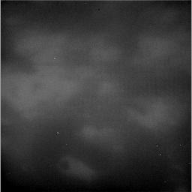
February 10, 2012
Credits: NASA/JPL/Space Science Institute - Credits for the additional process.: Dr Gianluigi Barca/Lunar Explorer Italia/IPF
|
Titan is the only known moon in the whole Solar System that has a fully developed Atmosphere (meaning an Atmosphere that consists of more than just trace gases). Observations from the NASA - Voyager Space Probes have shown that the Titanian Atmosphere is denser than Earth's, with a Surface Pressure about 1,45 times that of Earth's. Titan's Atmosphere is about 1,19 times as massive as Earth's overall, or about 7,3 times more massive (on a "per surface area basis"). Such an Atmosphere supports opaque Haze Layers that block most of the Visible Light coming from the Sun and other sources (like Saturn itself!), thus rendering Titan's Surface Features very obscure and extremely hard to define. Titan's lower Gravity means that its Atmosphere is far more extended than Earth's and even at a distance of about 975 km from the Surface, the NASA - Cassini Spacecraft had to make several adjustments in order to maintain a stable orbit against Atmospheric Drag. The Atmosphere of Titan is opaque at many wavelenghts and a complete Reflectance Spectrum of the Surface is impossible to acquire from the outside. It was not until the arrival of the NASA/ESA/ASI - Cassini/Huygens Mission, in 2004, that the first direct images of Titan's Surface were obtained. The Huygens Probe was unable to detect the direction of the Sun during its descent, and although it was able to take a few images from the Surface, the Huygens Team compared the results of this (very limited, however) imaging attempt to "taking pictures of an asphalt parking lot at dusk". The presence of a significant Atmosphere around Titan was first suspected by Spanish astronomer Josep Comas Solà, who observed distinct Limb Darkening on Titan in 1903, and then confirmed by Gerard P. Kuiper in 1944, using a spectroscopic technique that yielded an estimate of an Atmospheric Partial Pressure of Methane of the order of 100 millibars. Subsequent observations made in the 1970s, showed that Kuiper's figures had been significantly underestimated: Methane abundances in Titan's Atmosphere were ten times higher, while its Surface Pressure was at least twice the figure that he had predicted. The high Surface Pressure meant that Methane could only form a small fraction of Titan's Atmosphere. In 1981, the NASA - Voyager 1 Space Probe made the first detailed observations of Titan's Atmosphere, revealing that its Surface Pressure was higher than Earth's, at 1,5 bars. Titan's Atmosphere is the only dense, Nitrogen-rich Atmosphere in the Solar System aside from the Earth's. The Atmospheric Composition of the Stratosphere is 98,4% Nitrogen with the remaining 1,6% composed mostly of Methane (1,4%) and Hydrogen (0,1– 0,2%). Because Methane condenses out of Titan's Atmosphere at high altitudes, its abundance increases as one descends below the Tropopause at an altitude of approx. 32 Km, leveling off at a value of 4,9% between 8 km and the Surface. There are trace amounts of other Hydrocarbons, such as Ethane, Diacetylene, Methylacetylene, Acetylene and Propane, as well as of other gases, such as Cyanoacetylene, Hydrogen Cyanide, CO2, CO, Cyanogen, Argon and Helium. The yellow/orange color as seen from Space must be produced by other more complex chemicals in small quantities, possibly Tholins and tar-like organic precipitates. The Hydrocarbons are thought to form in Titan's Upper Atmosphere in reactions resulting from the breakup of Methane by the Sun's UV Light, producing a thick orange smog. Titan has no Magnetic Field, although studies in 2008 showed that Titan retains remnants of Saturn's Magnetic Field on the brief occasions when it passes outside the Saturnian Magnetosphere and is directly exposed to the Solar Wind. This event may ionize and carry away some molecules from the top of the Atmosphere. In November 2007, scientists uncovered evidence of Negative Ions with roughly 10.000 times the mass of Hydrogen in Titan's Ionosphere, which are presumed to fall into the lower regions to form the orange haze that obscures Titan's Surface. Their structure is not currently known, but they are presumed to be Tholins, and may form the basis for the formation of more complex molecules, such as Polycyclic Aromatic Hydrocarbons. Energy from the Sun should have converted all traces of Methane in Titan's Atmosphere into more complex Hydrocarbons within 50 Million Years (a short time compared to the age of the Solar System), and this suggests that Methane must be somehow replenished by a reservoir on or within Titan itself. That Titan's Atmosphere contains over a thousand times more Methane than CO would appear to rule out significant contributions from cometary impacts, since comets are composed of more CO than Methane. That Titan might have accreted an Atmosphere from the early Saturnian Proto-Planetary Nebula at the time of formation also seems unlikely; in such a case, it ought to have atmospheric abundances similar to the Solar Nebula, including Hydrogen and Neon. Many astronomers have suggested that the ultimate origin for the Methane in Titan's Atmosphere is from within Titan itself, released via eruptions from Cryovolcanoes (but a possible biological origin for the Methane has not been discounted yet). There is also a pattern of Air Circulation found flowing in the direction of Titan's rotation, from West to East. Observations of the Titanian Atmosphere, made in 2004 by NASA - Cassini Spacecraft, also suggest that Titan is a "super rotator", like Venus, with an Atmosphere that rotates much faster than its Surface. Titan's Ionosphere is also more complex than Earth's, with the Main Ionosphere at an altitude of approx. 1200 Km but with an additional layer of charged particles at about 63. This splits Titan's Atmosphere to some extent into two separate "Radio-resonating Chambers". The source of natural ELF Waves on Titan is still unclear, as it does not appear to be an extensive lightning activity there. |
News visualized: 769 times

